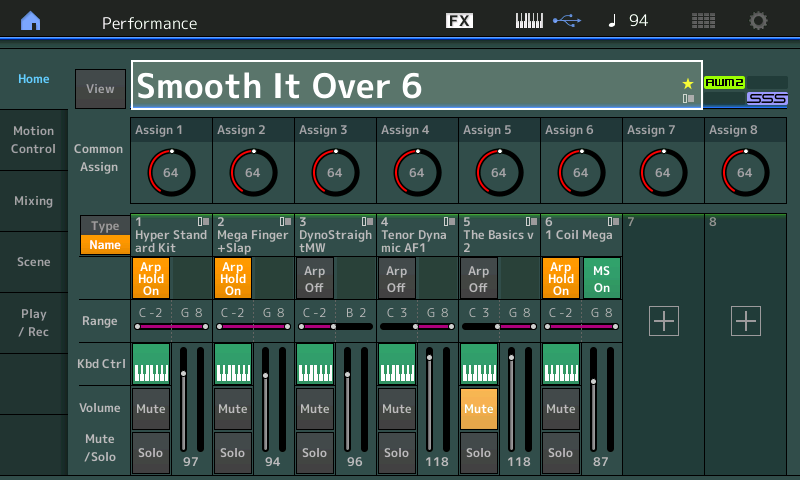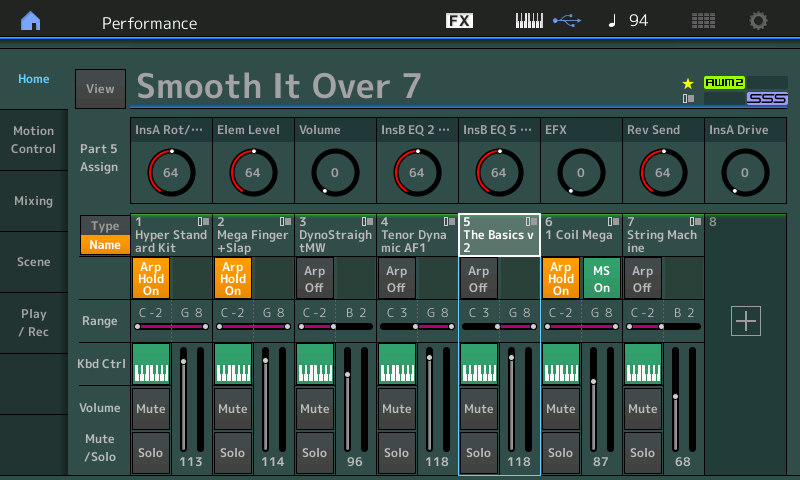Is it possible to control assignable knobs via MIDI? I just tried sending CC 23 messages to control assignable knob 7. It didn’t work at either the Part or the Performance level.
It would be really convenient to have a MIDI controller that was in control of assignable knobs. I’m hoping it’s possible somehow and I just didn’t hit the particular magic configuration.
In multi-channel MIDI mode, the Common level knobs ("Performance" ) are not CC controlled. They are SysEx. In single-channel mode, the Common level assignable knobs are CC controlled and when you twirl them, they do not send SysEx (they "act" as a PART knob in terms of MIDI output sent from Montage).
When you send CC 17-24, you need to also ensure the MIDI channel is set to the PART you want to target (assuming you're in multi-channel mode). If you're in single-channel mode, make sure the MIDI channel matches your configured (single) MIDI I/O channel.
Do you have super knob auto ON? That can twirl knobs and possibly override MIDI you send.
Do you have motion sequence turned ON? That can twirl knobs and possibly override MIDI you send.
Since it makes some amount of difference, what's your Montage's MIDI mode (single or multi channel)?
Current Yamaha Synthesizers: Montage Classic 7, Motif XF6, S90XS, MO6, EX5R
Thanks, Jason.
I have it all working fine now. The problem was that I had spent a lot of time on this yesterday and was pretty tired by the time I ran into this particular part of the problem. What was wrong was that I had the Cubase MIDI track I was using MUTED. So of course, nothing was getting through to the Montage. I just sat down to work on this and immediately spotted the problem.
Which reminds me of the old joke which can be told about programmers:
——————————————
Why do programmers have hunched shoulders and sloped foreheads?
Because when you ask them why their code doesn’t work, they shrug.
And when they figure it out, they hit their forehead with the heel of their hand.
CC, or Control Change, messages are in the category of Channel messages.
Assume MIDI I/O Mode = Multi;
Assume [ASSIGN] is lit;
When you are in a ‘common’ area, the eight Knobs are the “COMMON Assign Knobs”. By ‘common area’ we are referring to the cursor being in the HOME position or anytime your upper [COMMON] button is lit. On the main HOME screen, you will see the Knob icons referred to as “Common Assign”.

As you know, each of the 16 Parts has its own unique set of eight Assign Knobs. (A full set of MONTAGE Assign Knobs would be 136... 8 Common Assign plus a set of 8 for each of the 16 Parts (128).
When you *select* a Part, on the main HOME screen you will see the Knob icons referred to as “Part x Assign” where ‘x’ is the *selected* Part number.
The Short Story
The Common Assign Knobs must address parameters/functions that apply across the entire Performance and, therefore, send Sysex.
The Part Assign Knobs - each Part being a Motif XF on a separate Channel - Knobs send data on a specific Channel determined when the Part is *selected*.
The Details
When you *select* a Part, you can access its 8 Assign Knob controllers. They will generate cc number when moved directly*, as set for this Performance. The defaults are cc17-cc24, but you can change what they send Out on a per Performance basis.
*Moving the Super Knob qualifies as ‘indirect movement’ of an Assign Knob. Moving the Super Knob is a physical gesture. The physical gesture is what generates cc messages. The Super Knob can generate its own cc number or Sysex (your choice). In order for a Part Assign Knob to generate a cc message you must physically turn it while it is active.
This arrangement of Common and Part Assign Knobs allows you to play linked Parts via KBD CTRL, yet you can *select* a specific Part to control it in detail.

You could have a Performance where you are controlling Drums, Bass, Guitar (via Arps), Strings, and EPiano in the left-hand while directly performing with a B3 organ Part split on the right side. By *selecting* this Organ Part 5 directly, the 8 parameters you set for its Assign Knobs are available. If you then switch that Organ to a Saxophone Part 4, *selecting* that Part recalls the 8 parameters you decided to interact with for the Saxophone. Selecting a Part is transmitting on a different Channel... so the same number Knob, while still sending the same cc # message is now on a different Channel and can be something entirely different..
*Selecting* a Part has the benefit of giving you access to the Parts Elements or Operators... so in the example above not only are the 8 Knobs now addressing the Organ sound directly, the 8 Sliders are acting as the pseudo-drawbar arrangement.
If you envision the front panel with 136 Assign Knobs, it is helpful in reminding you that they are unique Knobs which can be doing different things depending on the context. Problems arise when you only see the 8 physical Knobs without considering the context. (The lighted front panel is your friend here). [PERFORMANCE CONTROL] takes on new meaning.
Additional Knob Functions
If [ASSIGN] is not lit, that means either the 24 “Quick Edit” parameters are in play, via 3 rows of functions (Tone/EQ-FX/Arp-MS) or the “Multi” Function is selected for side-by-side Pan, VarSend, RevSend.
If one of the three “Quick Edit” rows is lit, the parameter will show in the screen. Again you have a choice of COMMON (all Parts) or addressing a single *selected* Part. The purpose of the Quick Edit Knob Function area is to generate MIDI messages that can be played back to the MONTAGE, guaranteeing your every gesture is documented.
The [MULTI] Knob Function, is a convenient side-by-side arrangement of the Part controls for Pan (cc10), VarSend (cc94), and RevSend (cc91)... when mixing this is very much appreciated versus having to individually select a Part before accessing its controls.
Summary:
If you understand the Edit Common level of the architecture as separate from the individual Part Edit level of the architecture, the matter of knowing what the Knob is sending will be much clearer. It is when the MONTAGE is being used as a Multi-Part synth, that you can take advantage of its multiple channel transmitting capability. Having Assignable Controllers on their own MIDI Channel means you can determine exactly what that control does. The Part Assign Knobs are very much like any controller that does not have a fixed function attached... you decide what it controls, how much it varies the parameter, in what direction the application is applied.
MW (cc01) is an Assignable Controller, you decide on a per program basis what it does.
Vol (cc07) is an example of a Controller that has a function attached to it. It will always adjust channel Volume.
cc17-24 those used for the Part Assignable Knobs, by default, as you might guess, do not have any particular function attached... you decide on a per program, per Part basis what it does.
If you are sending In cc23, you need to define what Channel you are sending it In on... it will arrive in MONTAGE on the correspondingly numbered Part.
Next, navigate to a screen where you can see that Part’s Assign Knobs — cc23 will move Part Assign Knob 7
Whether or not this results in any sonic changes will depend on what parameter Destination you have assigned to Part X, Assign 7
Check the “Mod/Control” > “Control Assign” matrix to review what Assign Knob 7 is set to control for that Part.
Activate “Auto Select” (green), then turn Assign Knob 7 to populate the “Display Filter”
